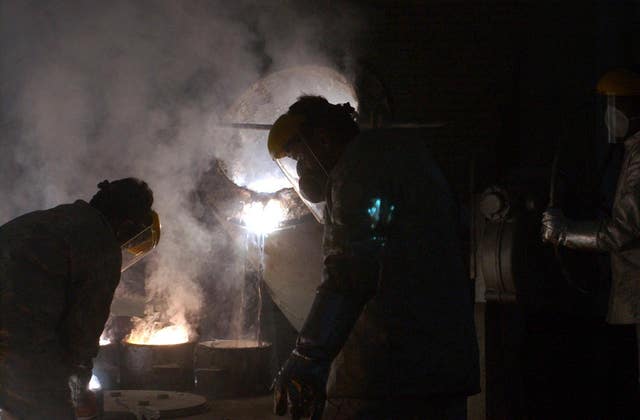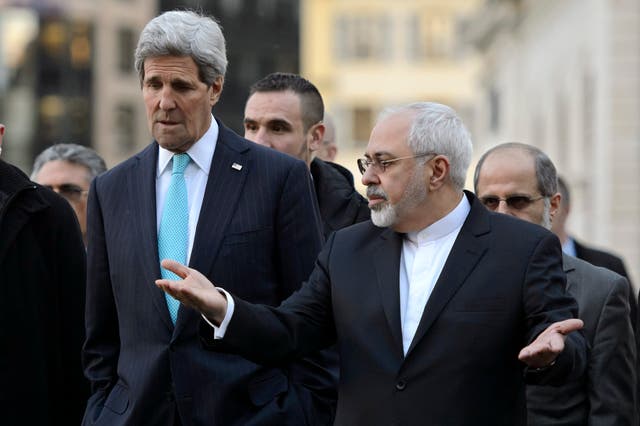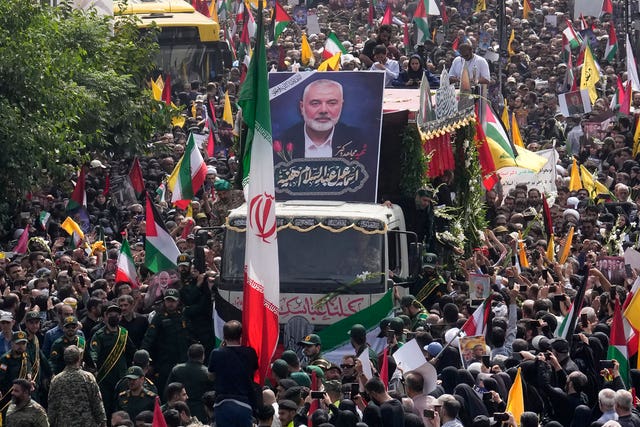
Iran and the United States held talks in the sultanate of Oman on Saturday, jump-starting negotiations over Tehran’s rapidly advancing nuclear programme.
Iran’s state-run broadcaster said US Middle East envoy Steve Witkoff and Iran’s Foreign Minister Abbas Araghchi “briefly spoke” together — the first time the two nations have done that since the Obama administration.
Mr Araghchi said more talks are planned for April 19.
The talks represent a milestone in the fraught relations between the two nations over Iran’s program, which is enriching uranium close to weapons-grade levels.
Here is a timeline of the tensions between the two countries over Iran’s atomic programme.
– Early days
1967 — Iran takes possession of its Tehran Research Reactor under America’s “Atoms for Peace” programme.
1979 — Shah Mohammad Reza Pahlavi, fatally ill, flees Iran as popular protests against him surge. Ayatollah Ruhollah Khomeini returns to Tehran and the Islamic Revolution sweeps him to power. Students seize the United States Embassy in Tehran, beginning the 444-day hostage crisis. Iran’s nuclear programme goes fallow under international pressure.
August 2002 — Western intelligence services and an Iranian opposition group reveal Iran’s secret Natanz nuclear enrichment facility.

June 2003 — Britain, France and Germany engage Iran in nuclear negotiations.
October 2003 — Iran suspends uranium enrichment.
February 2006 — Iran announces it will restart uranium enrichment following the election of hard-line president Mahmoud Ahmadinejad. Britain, France and Germany walk out of stalled negotiations.
June 2009 — Iran’s disputed presidential election sees Mr Ahmadinejad re-elected despite fraud allegations, sparking Green Movement protests and a violent government crackdown.
October 2009 — Under president Barack Obama, the US and Iran open a secret backchannel for messages in the sultanate of Oman.
July 2012 — US and Iranian officials hold face-to-face secret talks in Oman.
July 14 2015 — World powers and Iran announce a long-term, comprehensive nuclear agreement that limits Tehran’s enrichment of uranium in exchange for the lifting of economic sanctions.
– The nuclear deal collapses
May 2018 — During his first term, US President Donald Trump unilaterally withdraws the US from the nuclear agreement, calling it the “worst deal ever”. He says he will get better terms in new negotiations to stop Iran’s missile development and support for regional militias. Those talks do not happen in his first presidency.
May 8 2019 — Iran announces it will begin backing away from the accord. A series of regional attacks on land and at sea blamed on Tehran follow.
January 3 2020 — A US drone strike in Baghdad kills General Qassem Soleimani, the architect of Tehran’s proxy wars in the Middle East.

January 8 2020 — In retaliation for Gen Soleimani’s killing, Iran launches a barrage of missiles at military bases in Iraq that are home to thousands of American and Iraqi troops. More than 100 US service members suffer traumatic brain injuries. As Iran braces for a counterattack, the Revolutionary Guard shoots down a Ukrainian passenger plane shortly after take-off from Tehran’s international airport, reportedly mistaking it for a US cruise missile. All 176 people on board are killed.
July 2020 — A mysterious explosion tears apart a centrifuge production plant at Iran’s Natanz nuclear enrichment facility. Iran blames the attack on archenemy Israel.
April 6 2021 — Iran and the US under its president Joe Biden begin indirect negotiations in Vienna over how to restore the nuclear deal. Those talks, and others between Tehran and European nations, fail to reach any agreement.
April 11 2021 — A second attack within a year targets Iran’s Natanz nuclear site, again likely carried out by Israel.
April 16 2021 — Iran begins enriching uranium up to 60%, its highest purity ever and a technical step from weapons-grade levels of 90%.
February 24 2022 – Russia launches its full-scale invasion of Ukraine. Moscow ultimately will come to rely on Iranian bomb-carrying drones in the conflict, as well as missiles.
July 17 2022 — An adviser to Iran’s supreme leader, Kamal Kharrazi, says Iran is technically capable of making a nuclear bomb, but has not decided whether to build one. His remarks will be repeated by others in the coming years as tensions grow.

– Middle East wars rage
October 7 2023 — Hamas militants from the Gaza Strip storm into Israel, killing 1,200 people and taking 250 others hostage. This begins the most intense war ever between Israel and Hamas. Iran, which has armed Hamas, offers support to the militants. Regional tensions spike.
November 19 2023 — Yemen’s Houthi rebels, long supported by Iran, seize the ship Galaxy Leader, beginning a monthslong campaign of attacks on shipping through the Red Sea corridor that the US Navy describes as the most intense combat it has seen since the Second World War. The attacks mirror tactics earlier used by Iran.
April 14 2024 — Iran launches an unprecedented direct attack on Israel, firing more than 300 missiles and attack drones. Israel, working with a US-led international coalition, intercepts much of the incoming fire.
April 19 2024 — A suspected Israeli strike hits an air defence system by an airport in Isfahan, Iran.

July 31 2024 – Ismail Haniyeh, a Hamas leader, is assassinated apparently by Israel during a visit to Tehran after the inauguration of reformist President Masoud Pezeshkian.
September 27 2024 — Israeli airstrike kills Hezbollah leader Hassan Nasrallah.
October 1 2024 — Iran launches its second direct attack on Israel, though a US-led coalition and Israel shoot down most of the missiles.
October 16 2024 — Israel kills Hamas leader Yahya Sinwar in the Gaza Strip.
October 26 2024 — Israel openly attacks Iran for the first time, striking air defence systems and sites associated with its missile programme.
– Trump returns — and reaches out
January 20 2025 — Mr Trump is inaugurated for his second term as US president.
February 7 2025 – Iran’s Supreme Leader Ayatollah Ali Khamenei says proposed talks with the US are “not intelligent, wise or honourable.”
March 7 2025 – Mr Trump says he sent a letter to Ayatollah Khamenei seeking a new nuclear deal with Tehran.
March 15 2025 — Mr Trump launches intense airstrikes targeting Houthi rebels in Yemen, the last members of Iran’s self-described “Axis of Resistance” capable of daily attacks.
April 7 2025 — Mr Trump announces the US and Iran will hold direct talks in Oman. Iran says they will be indirect talks, but confirms the meeting.
April 12 2025 — First round of talks between Iran and the US take place in Oman, ending with a promise to hold more talks after US Middle East envoy Steve Witkoff and Iranian Foreign Minister Abbas Araghchi “briefly spoke” together — the first time the two nations have done that since the Obama administration.
April 19 2025 — Next round of talks scheduled between the US and Iran.



Comments: Our rules
We want our comments to be a lively and valuable part of our community - a place where readers can debate and engage with the most important local issues. The ability to comment on our stories is a privilege, not a right, however, and that privilege may be withdrawn if it is abused or misused.
Please report any comments that break our rules.
Read the rules hereYou must verify your phone number before you can comment.
Please enter your phone number below, and a verification code will be sent to you by text message.
Please enter the six-digit verification code sent to you by SMS.
Your verification code has been sent a second time to the mobile phone number you provided.
Your verification code has been sent a third time to the mobile phone number you provided.
You have requested your verification code too many times. Please try again later.
Didn’t receive a code? Send it againThe code you entered has not been recognised.
Please try again
You have failed to enter a correct code after three attempts.
Please try again later.
Your phone number has been verified.
Your phone number has been stored with your account details. We will never use it for anything other than verifying that you are the legitimate owner of this account.